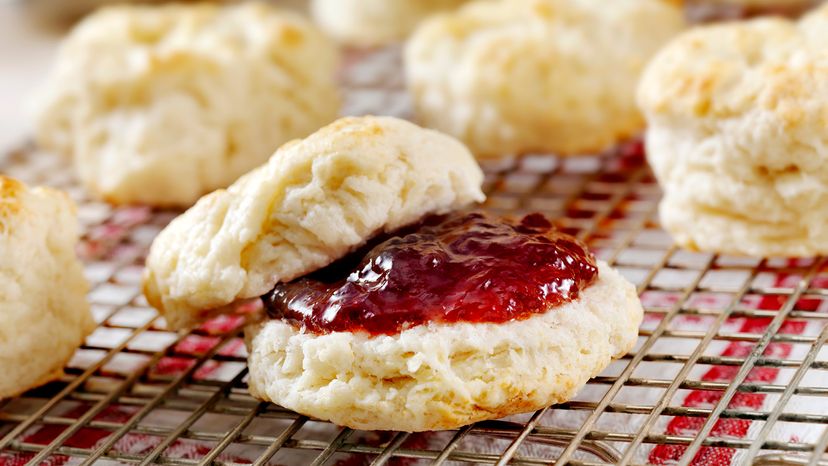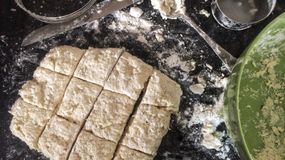“
 “Biscuits as we know them today didn’t exactly start out that way. LauriPatterson/Getty Images
“Biscuits as we know them today didn’t exactly start out that way. LauriPatterson/Getty Images
Admit it: When you think of light, fluffy biscuits, you probably think of Southern food. And we get it. Biscuits just pair naturally with traditional Southern fare like fried chicken, biscuits and gravy, and homemade jam.
But biscuits like those we eat today in the U.S. are fairly modern culinary creations. Throughout much of history, biscuits weren’t at the center of dreamy breakfasts or chicken dinners — they were hard, thin, durable, dry and meant for survival.
The word biscuit comes from the Latin word "panis biscoctus," which means "twice baked" — and so it’s no coincidence that a biscuit is similar to biscotti, the cookies that actually are twice baked. Soldiers in ancient Rome received "hard biscuits" — they had no leavening agent or fat so they lasted a long time — in their rations. In fact, hard biscuits of some type were the meals ready to eat (MREs) of military personnel for centuries, and have been known by the names "hardtack," "ship’s biscuit," "sea biscuit" and "pilot bread."
Fast forward to the antebellum South. Biscuits were still tough and flat, and typically were only eaten only in wealthy homes. Most people living in the South at the time ate cornbread instead. That’s because most mills in the South were great at grinding corn but not at processing wheat. So only the rich could afford flour, which often had to be shipped in from northern states.
Beaten biscuits, which could be considered the precursor to the modern Southern biscuit, were only a little better than hardtack. They included fat like butter or lard, but still no leavening agent, so beaten biscuits remained flat and only slightly lighter because the dough required 15 minutes of kneading or beating.
It wasn’t until several 19th-century innovations came along that we got what’s now recognized as a Southern biscuit. First, better flour mills — most of them in the Midwestern U.S. — and increased wheat production dropped the price of flour enough that poor Southerners could also afford to buy flour. And, the development of chemical leavening agents, such as pearl ash (potassium carbonate), potassium bicarbonate, and sodium bicarbonate — what we now call baking soda — helped biscuits reach new heights, without yeast or beaten eggs.
Basic Southern Biscuits Recipe
A few things are important in biscuit baking. Keep your butter cold. Don’t get it too soft while you’re working it into the flour. You want the butter to melt when the biscuits are cooking in the oven, because melting butter produces steam that will help the biscuits rise.
Also, to make the most of the leavening power of baking soda and baking powder, bake the biscuits as soon as you mix the wet and dry ingredients together. Baking soda starts to work as soon as it’s moist, and those biscuits will lose some height if you let the dough sit. Finally, use a biscuit cutter, cookie cutter or a sharp knife to cut the biscuit dough. Don’t use a glass. And if you use a cutter, don’t twist it. Nice clean edges help the dough rise.
Ingredients
- 2 cups (8.5 ounces) all-purpose flour
- 2 teaspoons baking powder
- 1 teaspoon salt
- 1/2 teaspoon baking soda
- 1/2 cup (1 stick) cold butter, cut into cubes
- 2/3 cup (5.3 fluid ounces) cold milk
- Optional ingredients: 1 teaspoon or more of freshly ground black pepper; 1 tablespoon or more of fresh thyme
Preparation
1. Heat the oven to 450 degrees Fahrenheit. Line a baking sheet (with no rims) with parchment paper.
2. In a large bowl, combine the flour, baking powder, salt and baking soda with a whisk. (If you are using the black pepper or thyme, add them here.)
3. Drop the butter cubes into the flour and toss them in the flour. Use your fingertips to quickly rub the butter into the flour, until the butter pieces are all flat and some are the size of rice. Having some larger pieces is fine. Put the bowl in the freezer for 15 minutes to chill the butter.
 “
“ “Biscuit dough is relatively easy to make and doesn’t require any resting and rising like bread dough does.Jon Lovette/Getty Images
“Biscuit dough is relatively easy to make and doesn’t require any resting and rising like bread dough does.Jon Lovette/Getty Images
4. Remove the bowl from the freezer. Make a well in the center of the flour mixture and pour the milk in all at once. Combine with a fork until a dough forms.
5. Turn the dough out onto a lightly floured surface and gently pat it into a square. Fold the dough in half onto itself, and pat it out again. Repeat until all the flour is incorporated into the dough. Pat out the dough one last time, to about 1/2-inch thick. Use a 2-inch biscuit cutter to cut the biscuits into square or rounds. If you have dough scraps, you can gently pat them together and cut more biscuits. (Don’t do this more than once; the biscuits will be tough.)
6. Place the cut biscuits onto the lined baking sheet. Place them close together for biscuits that rise high and have soft sides. For biscuits with crispier edges, place them an inch or more apart.
7. Bake the biscuits for 15 minutes or until they are golden brown.
Recipe courtesy Shaun Chavis
Now That’s Crazy
After the Civil War, early blues singers used food as metaphors for sex. The word "biscuit" described an attractive woman, and the term "biscuit roller" described a woman who was good in bed.


